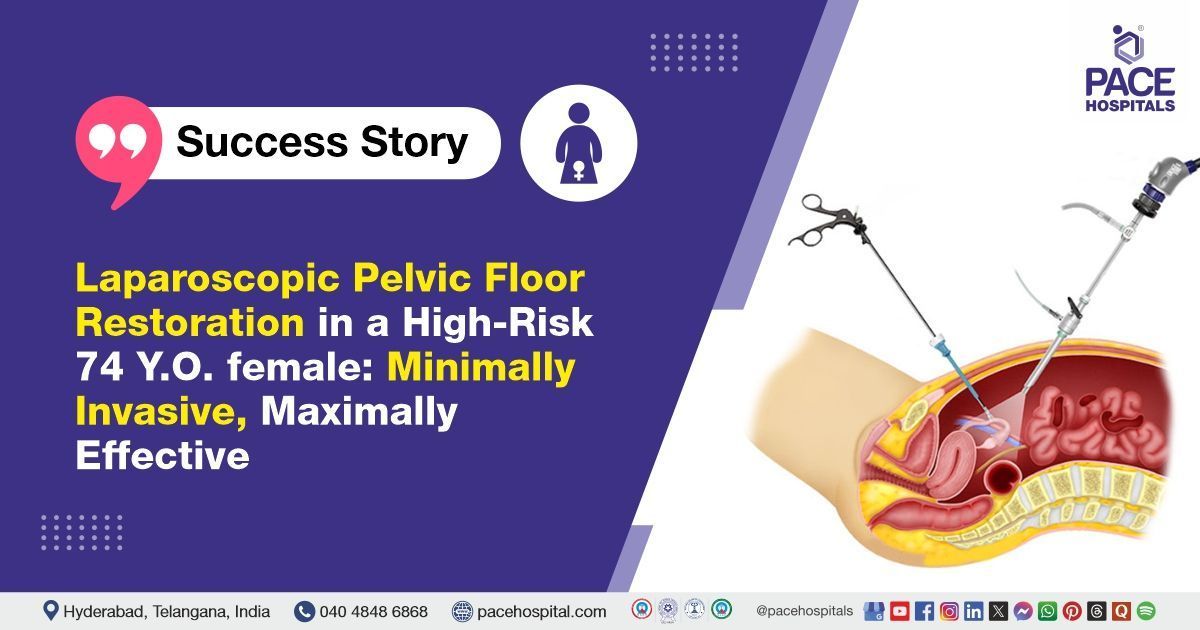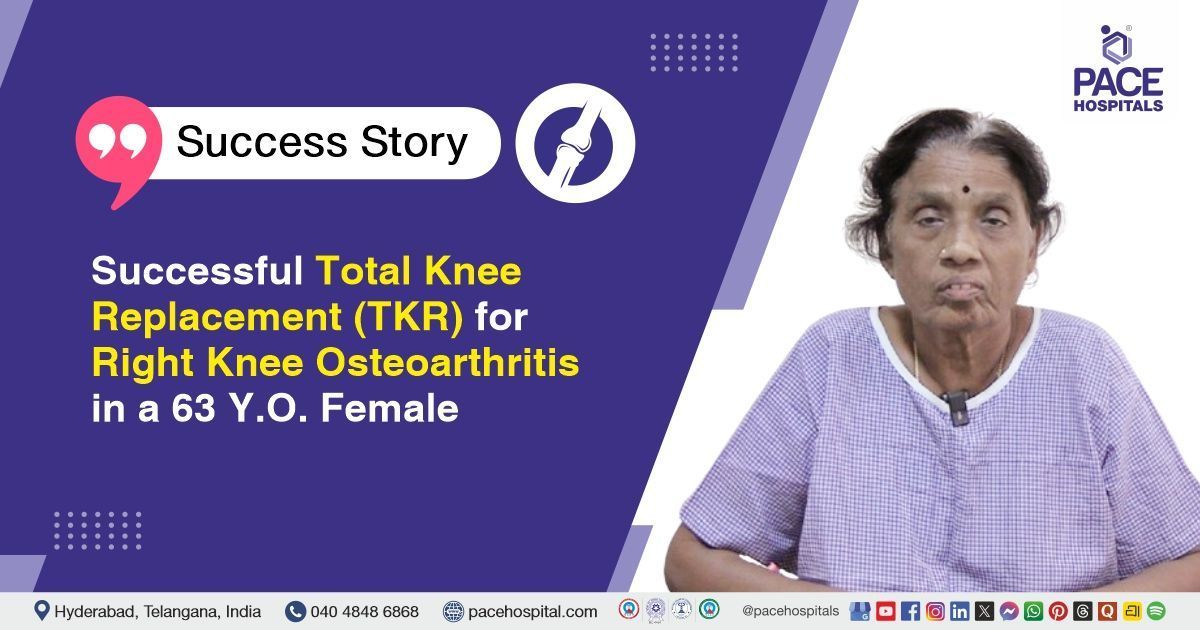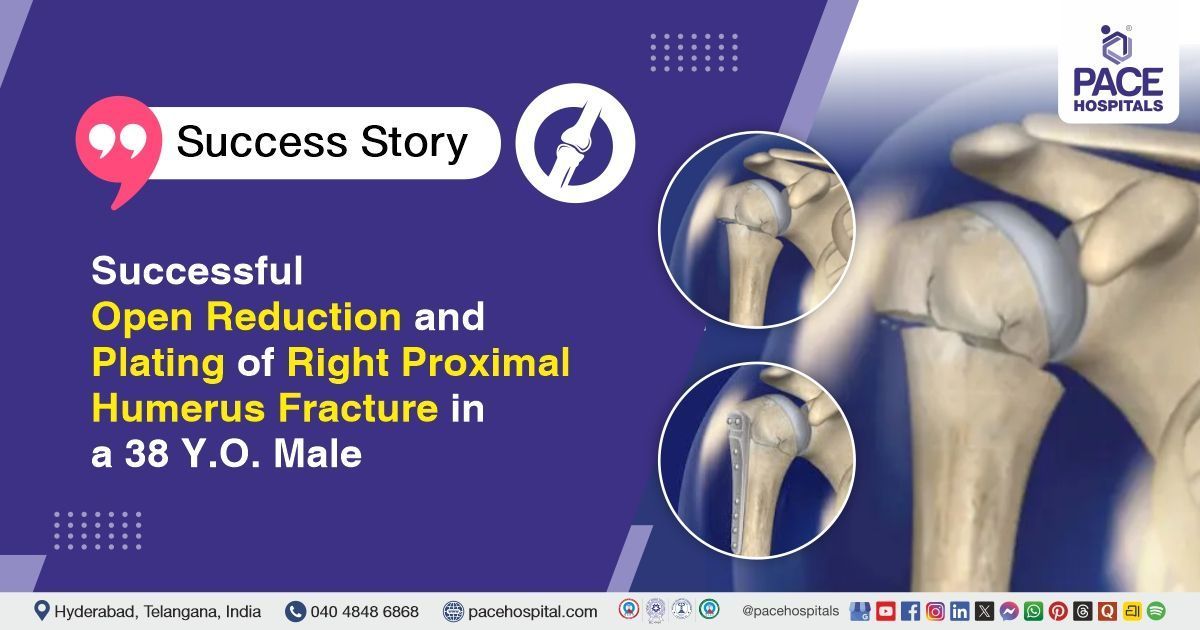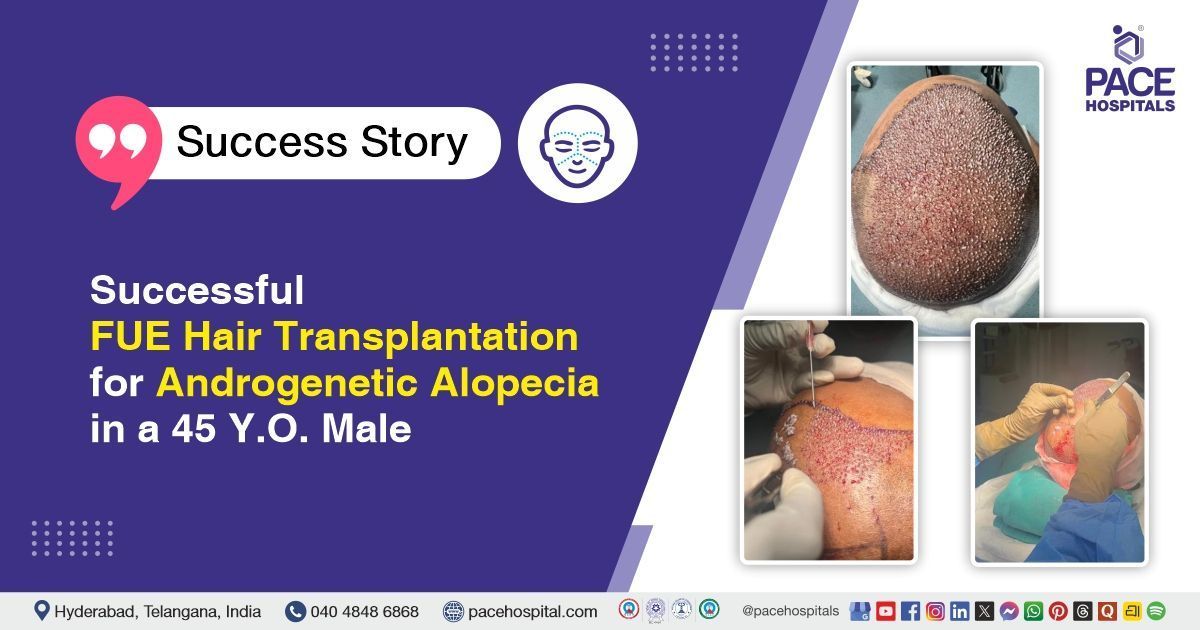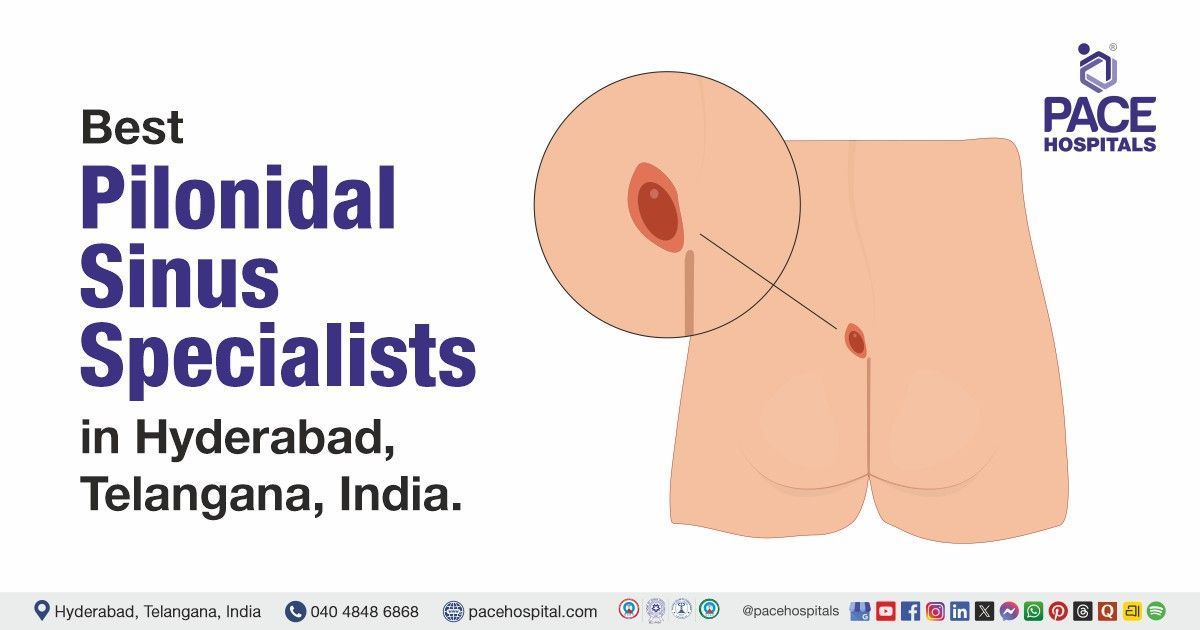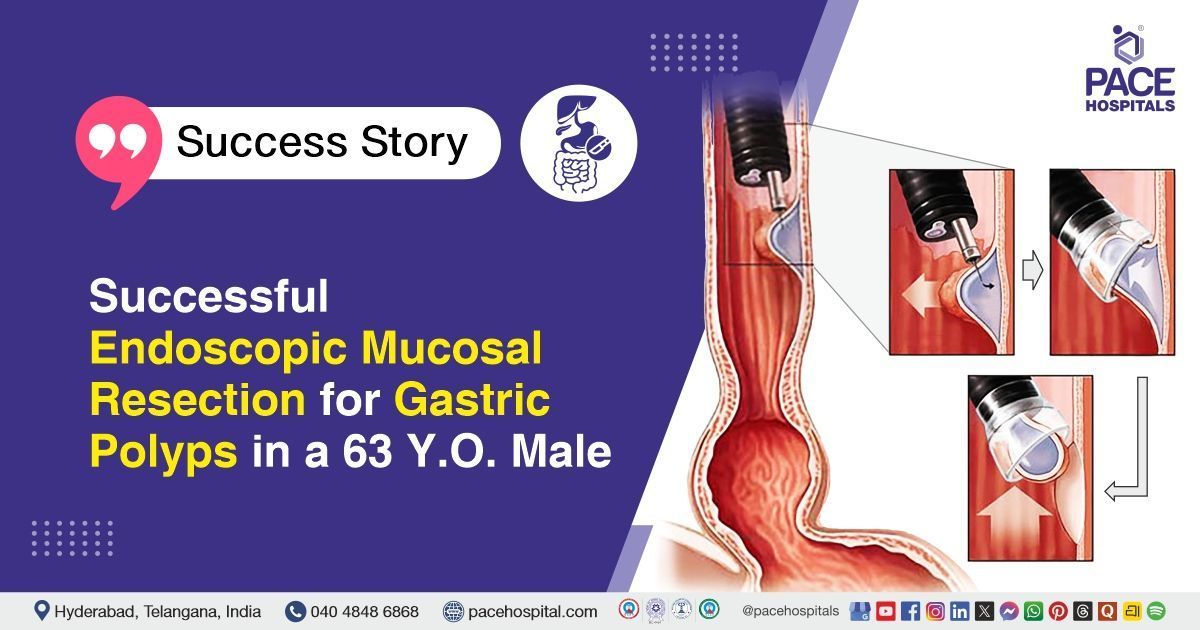Laparoscopic Pelvic Floor Restoration in a High-Risk 74 Y.O. female: Minimally Invasive, Maximally Effective
PACE Hospitals
The gynaecology team at PACE Hospitals successfully performed a total laparoscopic hysterectomy with bilateral salpingo-oophorectomy and adhesiolysis for a female patient with third-degree uterovaginal prolapse and first-degree cystocele, achieving complete anatomical correction and symptomatic relief.
Chief Complaints
The patient, a 74-year-old female from KPHB, Kukatpally, presented to the Department of Gynaecology at
PACE Hospitals, Hitech city, Hyderabad with the chief complaints of a sensation of something protruding from the vagina for approximately two years. Notably, she reported no associated voiding difficulties or bowel dysfunction, but the persistent prolapse caused significant physical discomfort and compromised her quality of life.
Medical History
A comprehensive review of the patient's medical history revealed well-controlled hypertension and diabetes mellitus, both managed with regular medications.
The patient's gynaecological timeline revealed a natural transition to menopause approximately fifteen years prior, marking the cessation of her reproductive years. Her obstetric history reflected a successful childbearing period, documented as P3L3, indicating three full-term vaginal deliveries, all achieved through uncomplicated spontaneous vaginal births. Notably, her medical background was uncomplicated by familial predispositions or allergic sensitivities, presenting a clean slate for therapeutic intervention.
On Examination
The patient was moderately built and well-nourished, with a BMI indicative of normal weight, appearing conscious, coherent, and cooperative during the examination. There were no signs of pallor, icterus, or cyanosis. Her vital signs were stable and within normal limits. Systemic examination revealed normal heart sounds (S1 and S2) with no murmurs on cardiovascular assessment, while the respiratory system showed clear air entry bilaterally with no added sounds. Abdominal examination demonstrated a soft, non-tender abdomen without any palpable masses or organomegaly. Pelvic examination confirmed postmenopausal genital changes, with evidence of third-degree uterovaginal prolapse on inspection.
Diagnosis
After a thorough comprehensive evaluation, the patient's condition was diagnosed by combining clinical assessment with targeted diagnostic tests. The diagnostic process began with a thorough pelvic examination, which clearly revealed the hallmark findings of third-degree uterovaginal prolapse - complete protrusion of the uterus beyond the vaginal introitus - along with first-degree cystocele. These physical findings correlated precisely with her two-year history of vaginal bulge sensation.
To confirm the extent of pelvic organ descent and evaluate surrounding structures, advanced imaging modalities were employed, including pelvic floor ultrasound to assess dynamic support defects and MRI for detailed soft tissue visualization. The combination of characteristic physical examination findings with imaging confirmation established the definitive diagnosis, while simultaneously ruling out other pelvic floor disorders or occult pathology that might complicate management. This multimodal diagnostic approach ensured both anatomical precision and clinical correlation for optimal treatment planning.
Medical Decision Making
Considering the patient's refractory symptoms and the progressive nature of pelvic organ prolapse, Dr. Mugdha Bandawar, Consultant Gynecologist and Laparoscopic Surgeon, recommended a total laparoscopic hysterectomy with bilateral salpingo-oophorectomy and adhesiolysis as the definitive treatment, emphasizing that this surgical approach would not only address the current prolapse but also prevent future recurrence by removing the atrophic uterus and adnexa (the parts adjoining an organ) that were contributing to the pelvic floor dysfunction.
The decision for laparoscopic rather than open surgery was made after careful evaluation of the patient's comorbidities, after noting that the minimally invasive approach would significantly reduce surgical trauma, postoperative pain, and recovery time, particularly crucial for this elderly patient with diabetes. Preoperative optimization included strict glycaemic control and cardiovascular assessment under Dr. Mugdha’s supervision, with collaborative input from the endocrinology and cardiology doctors teams to ensure surgical safety.
Surgical Procedure
The patient underwent a Total Laparoscopic Hysterectomy in Hyderabad at PACE Hospitals along with Bilateral Salpingo Oophorectomy and Adhesiolysis under general anaesthesia. Laparoscopic findings included a small postmenopausal uterus, atrophied bilateral tubes and ovaries, and omental adhesions to the anterior abdominal wall, which were lysed (broken down) during adhesiolysis. The entire procedure was completed without intraoperative complications, and the vaginal vault was securely closed. The excised specimens were sent for histopathological examination to rule out occult pathology. The procedure adhered to standardized laparoscopic protocols, emphasizing meticulous tissue handling and haemostasis.
Postoperative Care
Post-surgery, the patient was monitored in the surgical intensive care unit for stability before transitioning to a private ward. She received intravenous antibiotics, analgesics, antiemetics, and gastric protectants to prevent infection, manage pain, and ensure comfort. Daily wound care and vital monitoring were performed, with no postoperative fever or bleeding noted. Her recovery was uneventful, and she maintained a stable hemodynamic state throughout her hospitalization.
Discharge Medications
Upon discharge, the patient was prescribed a course of oral antibiotics, proton pump inhibitors, anti-inflammatory analgesics, and enzymatic anti-inflammatory medication to reduce inflammation and promote healing. Additionally, she was advised to apply a topical antibiotic ointment to avoid superficial infections. Her regular antihypertensive and antidiabetic medications were continued as before.
Urgent care
The patient was clearly advised to contact her treating gynaecologist immediately if experiencing any of the warning signs such as persistent constipation, increasing abdominal discomfort, fresh vaginal bleeding, or fever. These symptoms may indicate postoperative complications requiring urgent medical attention.
Follow-Up
The patient was scheduled for regular monitoring in the Gynaecology OPD, with the first postoperative visit planned after one week to evaluate surgical site healing and review histopathology findings. Subsequent follow-ups were advised to assess long-term pelvic floor support and address any concerns regarding vaginal vault integrity or recurrent symptoms.
Conclusion
This case emphasizes the effectiveness of laparoscopic procedures (TLH with BSO) for uterine prolapse treatment in Hyderabad, India, particularly in elderly patients with coexisting medical conditions.
Advantages of the Minimally Invasive Approach in Geriatric Gynecologic Surgery
For this 74-year-old patient with multiple comorbidities including diabetes and hypertension, the gynecologist/gynecology doctor decision to pursue total laparoscopic hysterectomy offered several critical advantages that directly addressed her high-risk status. The minimally invasive nature of the procedure proved particularly valuable in this elderly patient, where traditional open surgery might have posed significant cardiopulmonary risks.
Through four small abdominal incisions (each less than 1 cm), the gynecologist achieved complete visualization of the pelvic structures while minimizing tissue trauma - a crucial factor given the patient's diabetic predisposition for impaired wound healing.
The laparoscopic approach provided the gynecologist with magnified, high-definition visualization of the pelvic anatomy, enabling precise identification and preservation of the ureters and bladder during dissection - especially important given the patient's coexisting cystocele. This enhanced visualization proved invaluable when addressing the unexpected omental adhesions, allowing the gynecologist to perform concurrent adhesiolysis without needing to convert to an open procedure.
Share on
Request an appointment
Fill in the appointment form or call us instantly to book a confirmed appointment with our super specialist at 04048486868

